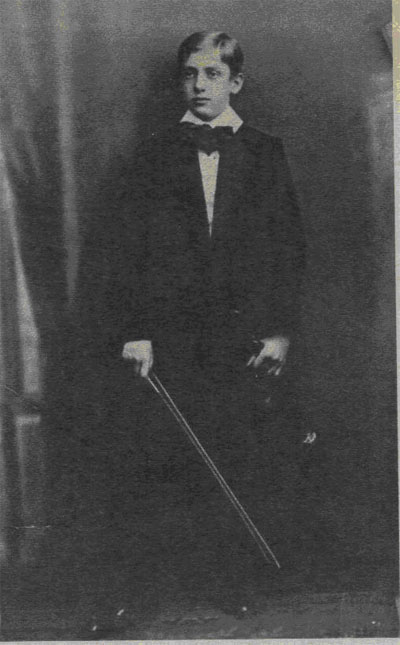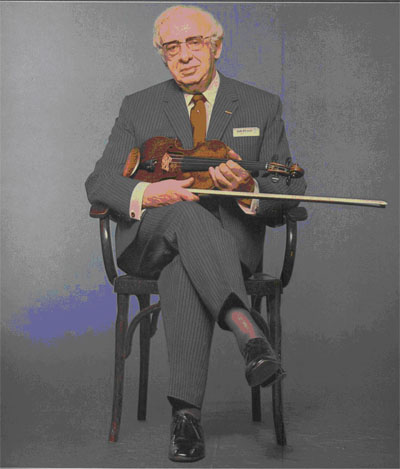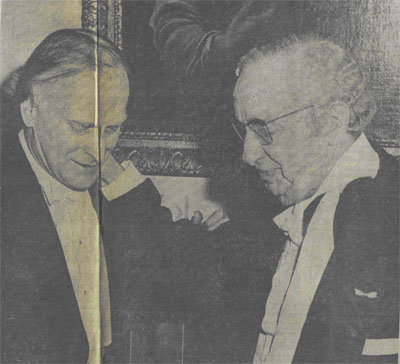
Paul GODWIN
Und seine Jazz-symphoniker
CD Jube Musikproduktion Nr 15012

Pol Godwin was born in 1902 as Pinchas Goldfein in Sosnowitz (then Czarist Russia now Sosnowiec in Poland) .From an early age on he was sent out with his violin to play at weddings, in cafés and cinemas. At the age of ten Latvian violinist Herman Kaplan declared him a ‘wunderkind’ and took him to his home in Vienna where the young boy had to play’ housemaid’ in return for lodgings and food. At the end of WWI he moved to Budapest where he studied for two years with Jeno Hubbay, the lessons were paid through financial help of his father and by playing constantly at the wedding-café circuit. After the rise of Horthy he moved on to Berlin where he studied under Willi Hess and Issay Barmas for a while. After he joined the Haller Revue -and being engaged by the Nelsson Cabaret- Pinchas via Pincus became Paul Godwin. As a violinist and ensemble leader his popularity began to rise very quickly and this popularity got a boost thanks to the grammophon record company for whom he recorded countless ‘tanz’ discs with his various ensembles. He also accompanied several important vocal artists of the Grammophon company such as Otto Reuter, Max Hansen, Franz Volker and Helge Roswaenge. (see soundbites)


With Hitler’s rise to power he not only lost his fortune but also his first ‘aryan’ wife who deserted him from one day to another. Godwin fled to the Netherlands –via Luxemburg-with 8 marks in his pocket, his most treasured possession his Stradivarius violin and his new found ‘aryan’ girlfriend Friedel who would marry him later on and would become his devoted wife for the rest of his life. Godwin managed to re-establish a successful concert career (the famous Flemish band leader Francis Bay learned his trade with Godwin) until once more the Nazis put an end to it with the invasion of the Benelux. Up until the deportations he appeared at several concerts given by the Dutch Jewish Cultural League at the ‘Hollandsche Schouwburg’ especially in Rudolf Nelson shows and in the shows of the Jewish Cabaret ensemble of Henriette Davids. Both Henriette Davids and the Viennese singer Sylvia Grohs remember these events in their biographies.
From July 1942 onwards more hard times followed and as most people from mixed marriages he was put into forced labour yet survived the war. His 3 brothers and one sister all ended up in the gass chambers. After WWII Dutch Vara radio gave him free lance work and when in 1951 he became a Dutch citizen the radio offered him a permanent contract. He also joined several ensembles and though he would never reach again the star status he once had in pre-1933 Berlin a normal happy life could now follow. In his own words ‘I conquered suffering and managed to keep the art to enjoy life’. That joy though got a fatal blow when in 1971 his wife died and he fell into a serious depression which lasted for several months. Paul Godwin died on 9 December 1982 in Driebergen in the Rosa Spier house, an old age home for elderly musicians. He donated his Stradivarius to the Oscar Back Fonds. Several years ago it came into the possession of the Nationaal Muziekinstrumenten Fonds (NMF), that named it the ” Paul Godwin Stradivarius”; it is currently on loan to Dutch violinist Birthe Blom.
At long last a CD re-issue is now available including several of his ‘Tanzplatte’ recorded between 1926 and 1932. The 24 records on this cd include tangos (one even composed by Tito Schipa), jazz numbers and lots of foxtrots. On most of these recordings the soloist is Leo Monosson. Monosson who was one of the most popular ‘schlagersaenger’ of the Weimar republic also saw his career broken by the advent of the Nazis and left Germany for the States in 1933, he died in Jamaica in 1967. Philips and Vara both issued LP releases -four in total- with his post-war work, some of them sometimes turn up on ebay. On one of these records he plays music by his teacher Jeno Hubay with the accompaniment of the Vilna-born pianist Isja Rossican a friend from his days in Berlin. Rossican accompanied Kathleen Ferrier in her Concertgebouw recital but was soon taken over by an illness which prevented him from continuing his career as a musician. Rossican died in 1968..

After his joint-concert with Menuhin
Rudi van den Bulck, operanostalgia